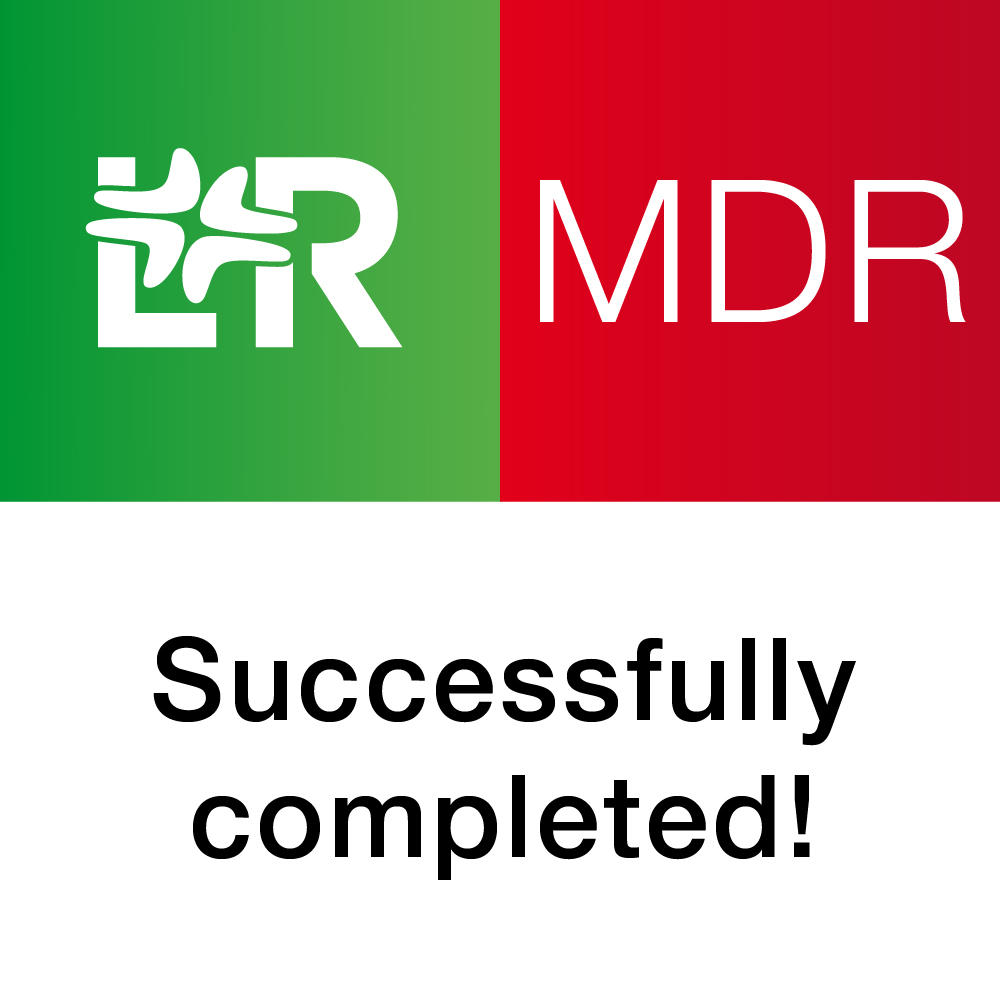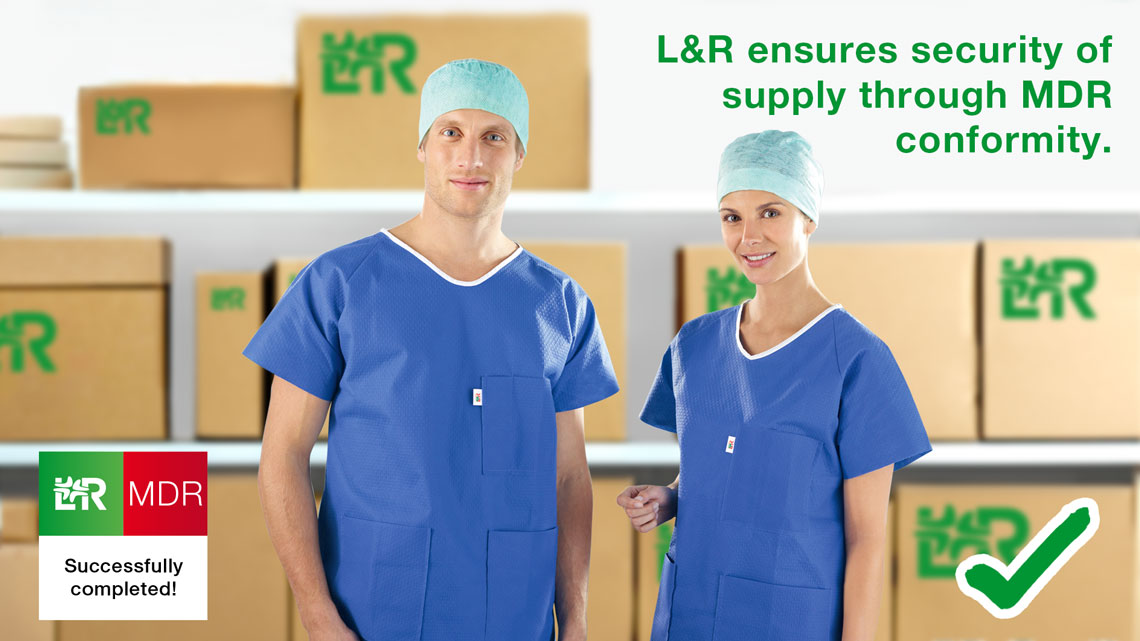L&R successfully completed MDR conformity:
Delivery capability and security of supply ensured!
As a partner and solution provider for our customers, patients and healthcare systems, we know that high-quality, safe products and dependable delivery are essential for our customers’ operations. As such, we have some fantastic news to share:
✓ On 24 May 2024, L&R was awarded MDR certificates for its Class Is, IIa, and IIb products and its procedure packs (e.g. Kitpack and CNP sets) by the notified body TÜV Süd
✓ Our products are MDR-compliant – and as safe and effective as ever
✓ Our internal quality management and all regulatory processes meet the MDR requirements and have been MDR-certified since 2019.
✓ Existing L&R products will continue to be legally marketed within the statutory transition period until 2027-2028.
What does this mean for our customers:
✓ As in the past, L&R ensures that only compliant products will reach the market – for the benefit of our customers and patients alike.
✓ The products are now also in compliance with the MDR.
✓ We can continue to reliably supply our products to healthcare systems and our customers.
You’re in safe hands with L&R. We’re your go-to expert solution provider – today and tomorrow!
L&R offers its customers:
- Safe, high-quality products
- Dependable supply
- Transparent communication about product availability
Questions?
If you have further questions, please check our:
FAQs
fact sheet
contact form

What is the MDR?
The MDR (Medical Device Regulation) is the EU Regulation concerning medical devices (EU 2017/745), which came into force on 26 May 2017 and has gradually become mandatory for the various medical device classes.
Transitional periods may apply to certain device groups until 2028.
What does the MDR regulate?
The European Medical Device Regulation regulates the placing on the market of medical devices throughout Europe and stipulates the requirements for the conformity assessment of medical devices.
The Regulation applies to all medical device manufacturers seeking to place their devices on the market within the EU.
Our journey to MDR compliance
✓ Since 2017, an internal project team has been working flat out to ensure that L&R is ready for the MDR.
✓ The notified body for L&R (TÜV Süd Product Service) is MDR-accredited.
✓ L&R is one of the first European companies to undergo and pass an MDR audit.
✓ Our Class I products have been MDR-compliant since 2021.
✓ L&R submitted the technical documentation for all higher-class devices (Is, II and III) and procedure packs (treatment units), e.g. Kitpack and CNP sets, to TÜV Süd in good time. On 24 May 2024, L&R was awarded MDR certificates for its Class Is, IIa and IIb devices and its procedure packs (e.g. Kitpack and CNP sets).
✓ Existing L&R products for which the MDD has been extended or transitional periods apply until 2027-2028 (Regulation 2023/607) will continue to be placed on the market legally. Our devices meet all of the relevant requirements.
What devices does the MDR apply to?
The new MDR applies to all medical devices once the respective transitional periods have elapsed.
Medical devices:
70% are Class I or Class Is
What does the MDR require from manufacturers and their devices ?
All manufacturers must have a quality management system which covers the development, production and monitoring of devices on the market. The MDR also stipulates having a risk management system. This must ensure that the benefits of the device are acceptable in view of the risks over the entire product lifecycle.
Device requirements:
- Device classification by risk class
- Meeting the essential safety and performance requirements and provision of technical documentation as evidence
- Clinical evaluation: The manufacturer must continuously check that the safety, performance and benefits of devices are maintained.
- Unique device identification (UDI): All medical devices must be given a unique identifier – the UDI. Devices must be registered with their UDI in EUDAMED (European Database for Medical Devices).
- Labelling: The MDR defines the information that the instructions for use, further accompanying materials and other labelling (e.g. labels, packaging) must contain.
In addition, manufacturers must employ at least one employee who is responsible for regulatory compliance (known as the “Person responsible for Regulatory Compliance”) and who ensures, among other things, that technical documentation is prepared in accordance with the company’s QM system.
- Depending on the risk class of the device, the manufacturer must undergo a conformity assessment procedure, with the involvement of the notified body (except for Class I devices). Once this has been successfully completed, the relevant certificate and declaration of compliance are issued and the CE marking is affixed to the product.
- Manufacturers must monitor medical devices throughout their entire life on the market (vigilance), continuously collect data about them (post-market surveillance) and address any problems arising during use of the device. If any risks are identified, the authorities must be informed.
What is the UDI?
The Unique Device Identifier (UDI) is a unique numeric or alphanumeric code for a medical device. This enables clear and unambiguous identification and helps with its traceability. The UDI is made up of the following components:
- A unique device identifier (UDI-DI)
- A production identifier (UDI-PI)
The new EU Regulation concerning medical devices (Medical Device Regulation, MDR) will replace the previous Medical Device Directives:
- Directive 93/42/EEC on medical devices (Medical Device Directive, MDD)
- Directive 90/385/EEC on active implantable medical devices (AIMD)
What is the legal status of the MDR?
As a European Regulation, as distinguished from European Directives, the Medical Device Regulation shall be applied as a European, supranational law within the stated period.
National specifications and requirements can be additionally regulated by national law in the individual countries of the EU.

Medical device portal of the European Commission: ec.europa.eu/growth/sectors/medical-devices/new-regulations_en
BfArM; PIP and Rofil breast implants: risks, information, recommendations
MDD: Medical Device Directive
entsprechend der Laufzeit der MDD-Zertifikate der jeweiligen Medizinprodukteklassen


